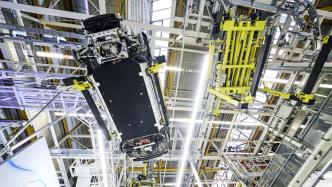
Mercedes-Benz's electrification strategy is undergoing adjustments.
According to Handelsblatt, the development of Mercedes-Benz's latest pure electric platform, MB.EA-Large, has been shelved because large luxury electric vehicles are not selling well and Mercedes-Benz has been forced to make "difficult cuts."
According to domestic media, Mercedes-Benz responded by saying that it "will not stop developing new pure electric vehicle architecture platforms; Mercedes-Benz remains committed to electrification transformation and will continue to launch new pure electric models. Mercedes-Benz is committed to creating the most suitable products for each customer and will flexibly provide models with multiple drive modes, including pure electric models and electrified fuel models."

Mercedes-Benz EQC electric vehicles are being assembled on the factory production line in Bremen, Germany.
The above response is basically consistent with the rhetoric Mercedes-Benz used when it adjusted its "all-electric" strategy. Not long ago, Mercedes-Benz postponed its 2025 electrification target to 2030, when the sales ratio of electrified vehicles will reach 50%.
At present, Mercedes-Benz is using "sustainable transitions between new models and existing model series" to further develop its product portfolio, and market conditions and customer wishes determine the pace of transformation. Now, they emphasize "giving the choice to customers."
Mercedes-Benz has many vehicle platforms. In order to clarify the relationships, let’s first briefly describe the application scenarios of Mercedes-Benz’s various electric vehicle platforms.
The MFA2 platform is used on the two compact electric vehicles, EQA and EQB. It is an oil-to-electric platform, upgraded from the MFA platform of the gasoline vehicle era.
The EVA platform is designed specifically for large sedans and SUVs and is a true pure electric platform. The current EQS, EQE, EQS SUV, and EQE SUV are all using it. The EVA platform uses a 400V voltage architecture.
The MMA platform is Mercedes-Benz's latest generation of pure electric platform. It is currently under development and is expected to be launched around 2025. It is mainly aimed at small and medium-sized vehicles and will replace the previous MFA2 platform in the pure electric field. MMA is Mercedes-Benz's first platform built on the 800V architecture. The CLA-class concept car unveiled at the Beijing Auto Show is the blueprint for the first mass-produced car on the MMA platform.
EA series platforms: divided into the MB.EA platform for medium and large vehicles, the AMG.EA platform for performance vehicles and the VAN.EA platform for commercial vehicles. The MB.EA platform will be used as the replacement technology for the EVA platform in the future, but this "future" is still very far away from us, at least after the MMA platform is launched in 2025, or even until 2030.
Among them, the MB.EA platform has two different specifications: MB.EA-Medium for C-Class and GLC, and MB.EA-Large for large electric vehicles such as S-Class, GLS, E-Class and GLE.
The latter is the platform that is currently rumored to be "shelved".
According to Handelsblatt, citing sources, the EQE and EQS series may not adopt the MB.EA-Large platform in the future, but will adopt the EVA2 platform, which is an upgrade of the EVA platform. At present, it has not been confirmed whether the EVA2 platform is a 400V or 800V architecture.
As the global demand for pure electric vehicles slows down, the life cycle of internal combustion engine models (both plug-in hybrid and gasoline hybrid have internal combustion engines) is extended accordingly, which means that more funds are needed to support the subsequent replacement of these internal combustion engine vehicles. Accordingly, it is reasonable to adjust the investment that was originally used in the "full electric" strategy, which was not so marginal.
At the annual shareholders' meeting last Wednesday, Ola Källenius, chairman of the board of directors of Mercedes-Benz Group, said: "In the next few years, (Mercedes-Benz) will have electric vehicles and ultra-modern electrified internal combustion engine models. If there is demand, they will even enter the 2030s." Strategically speaking, "Mercedes is focusing on zero emissions, that's for sure," Ola Källenius said, "but the transformation may be slower than expected."


